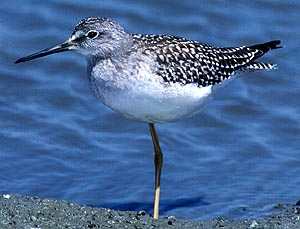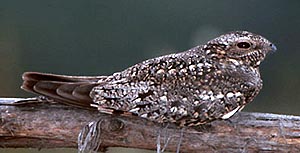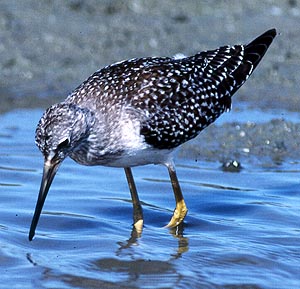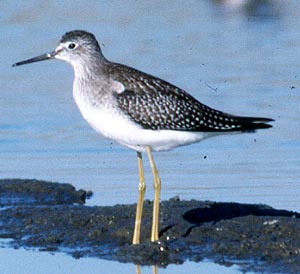

Photos © Peter LaTourrette and Don DesJardin
All rights reserved.
 |
 Photos © Peter LaTourrette and Don DesJardin All rights reserved. |
The nighthawk is a Lesser Nighthawk. Don DesJardin wrote: "It is a Lesser Nighthawk. Jim Greaves was right next to me when I photographed it. We flushed 3 birds, 2 adults and this one, which we figured was an immature. They nest in the Santa Clara River bottom. This one was near Saticoy." I was very impressed with the thoughtful analysis on this bird and I certainly learned a great deal from Al Jaramillo and others who contributed to the discussion.
I believe the yellowlegs is a Greater. A series of additional photos were taken at the same time, two of which are below. The left image reveals a much more coarsely marked breast than would be expected on a Lesser, which usually has the center of the breast, much paler than the mystery bird. It is fascinating how different angles change one's perception of relative bill length. Below right is a photo of a Lesser Yellowlegs taken at the same location two days earlier. It differs significantly from the mystery bird showing much less spotting on the back as well as a paler chest and a relatively shorter bill.
I believe that Steven Mlodinow's technique of measuring the bill/head ratios of the printed image and comparing
it to other printed images is useful. Furthermore, his idea that juveniles probably have shorter bills than adults
could help explain why yellowlegs identification may seem so intractable at times. The suggestion that the two
species have different head shapes was new to me, but the differences seem evident in the three photos below. The
mystery bird lacks the angled rear crown of the Lesser Yellowlegs on the right. Incidentally, I don't think anything
useful can be learned from the position of the nostril. I tried to measure nostril position on projected images
and it turned out to be useless.
 |
 Mystery above and left. Lesser Yellowlegs right © August 1986 Peter LaTourrette |
 |